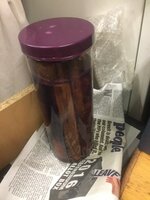BGrubb
Member
I found a small board, about three-quarter inch thick that had been underwater for a very long time and then in the sun for years. I cut the board into a number of pen blanks and they look like they may be really interesting to turn.
However, they are as light as balsa wood and I am pretty sure they won't turn well. I don't own a pressure pot and I am not interested in getting into that just yet. Is there any "wood hardener" liquid or other method I could try to harden these blanks? If so, I would fill the deep cracks with CA glue and I think I may get some really interesting pens out of them.

However, they are as light as balsa wood and I am pretty sure they won't turn well. I don't own a pressure pot and I am not interested in getting into that just yet. Is there any "wood hardener" liquid or other method I could try to harden these blanks? If so, I would fill the deep cracks with CA glue and I think I may get some really interesting pens out of them.

